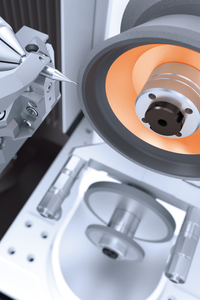

|
Edward Lowton
Editor |


|
| Home> | Production Engineering | >Machine centres and tools | >Selecting a production machine for medical industry tools |
Selecting a production machine for medical industry tools
07 August 2023
In medical manufacturing, everything has to adhere to the most stringent of standards. So, when it comes to surgical cutting tools for the industry, it's important to have a production machine you can rely on, says Carlos Becerra

WHILE MANY industry segments utilise tools manufactured from materials like HSS, carbide and PCD; tools for surgical applications and orthopaedics are often manufactured from stainless steel.
The main reason is that when surgeons are undertaking procedures like bone and cartilage drilling, grinding or shaving; carbide tools have the propensity to break or create excessive heat during operations. The ultra-hard characteristics that make carbide perfect for many manufacturing processes - are also the same attributes that make them unsuitable for invasive procedures. Surgical tools are generally manufactured from 17-4PH, 420, 440A, 455 or M2 tool steel with lengths from 50 to 250mm and diameters from 0.3 to 12mm.
However, with small diameters and a stainless grade with a likelihood to deflect during machining, precision production can be a challenge.
The steady rest and run-out
The steady rest is the single most critical factor in producing cutting tools to a standard beyond that made on rival machines. The innovative steady rest on the VGrind 340S supports the tool and prevents tool deflection during grinding.
Any tool deflection will have an adverse impact on not just the precision of the tool, but also the 'run-out'. Surgeons' hand tools typically operate at high speeds, exacerbating the 'run-out' impact of cutting tools. Run-out can result in reduced accuracy and even excess heat generation if a tool is rubbing against a bone instead of cutting. This can adversely affect the well-being of the patient.
Run-out of up to 5mm is common in tools that are not precisely manufactured with a supporting steady rest to prevent deflection. Not only can excessive run-out generate excessive heat, but it can also diminish precision where and when we need it most..
Preventing deflection
To categorically eliminate this obstacle, the steady rest on the VGrind 340S provides support under the tool to prevent deflection - but it also provides a supporting finger over the tool body support to eliminate movement. However, Vollmer has taken this a step further, providing two steady rest points, and not just one. The steady rest system supports the cutting flutes of the tool as well as the cutting tip of the tool. With typical tool shank diameters for hand tools being 4.5mm and the cutting flutes often much smaller, the potential for deflection grows with decreasing tool diameters.
Vollmer has doubled down on eliminating deflection, such is its importance and potential for disrupting the quality of cutting tools manufactured on the VGrind 340S. To eliminate deflection, we have also introduced automated tool run-out compensation. Integrated into the NUMROTO control software, the run-out compensation cycle will utilise a measuring probe during operation to probe tools in multiple positions around the diameter of the tool. Taking live 'in-cycle' measurements, the VGrind 340S will automatically measure the tool and re-calibrate the programme to accommodate and eliminate any tool deviations caused by deflection.
Automation
The OEM recipients that specify medical and surgical procedure tools often require high production volumes that can be in the region of 5,000-off. To support precision volume production, the VGrind 340S is supported by the HP160 automated tool loading system that can accommodate up to 900 tools. The HP160 loading system on the VGrind 340S facilitates 900 tools with the medical standard 4.5mm diameter shanks. The number of tool positions decreases depending upon the shank diameter.
Manufacturers can also set the machine to run multiple programmes sequentially without manual intervention. So, if a company needs to run a batch of 50 3-flute tools and then 500 2-flute tools of different diameters and geometry that are then followed by other tool variants - the VGrind 340S can easily accommodate this. The result is unmanned operation, reduced costs and around-the-clock production - all with complete process stability.
Carlos Becerra is rotary tooling application engineer at Vollmer of America
For more information:
Tel: 0115 9491040
- Grinding machine carves through blades
- Circular saw cuts cycle times
- Software opens new opportunities for saw blades
- Vollmer unveils digital roadmap for the future
- Made-to-Measure diamond tools
- Vollmer 'hitting the ground running' at AMB 2022
- Laser Focus With New VOLLMER Arrival
- Grinding technology for carbide tools
- Vollmer helps Systco achieve lights-out production


















